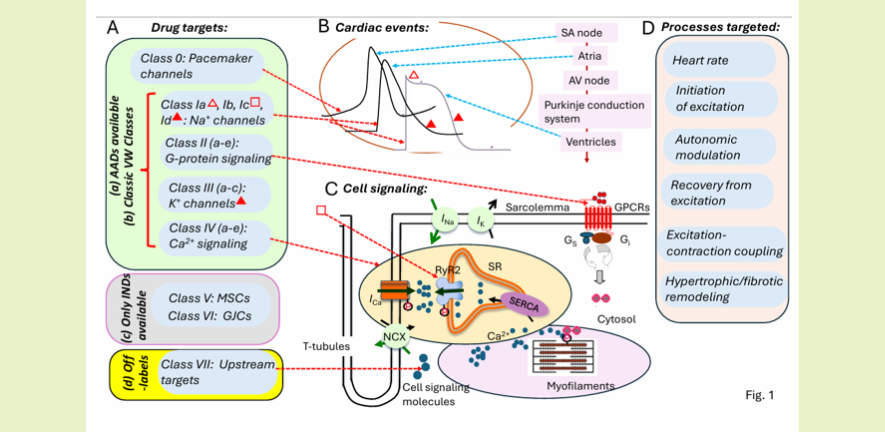
Submitted by Emily Rigby on Thu, 15/05/2025 - 13:21
Cardiac arrhythmias pose a serious global health challenge. The commonest sustained arrhythmia, atrial fibrillation (AF), affects 1–2% of the worldwide population. Antiarrhythmic drugs (AADs) remain central to their management. The historic, widely accepted Vaughan Williams (VW) classification based on then available (1975) electrophysiological knowledge has long required updating. Professors Chris Huang (University of Cambridge, BHF CRE), Ming Lei and Derek Terrar (University of Oxford, BHF Centre of Research Excellence/CRE), and Lin Wu (Peking University Hospital) developed and proposed the 2018 Oxford modernized antiarrhythmic drug (AAD) classification covering both use of established, and investigational new drugs (Circulation, 2018;138:1879–1896). This evolved from sustained electrophysiological research linking drug classes, target clinical events, signaling molecules, and the physiological processes they mediate (Fig. 1) (Physiol Rev. 2017; 97:283-409). It attracted extensive citations reflecting its global impact on AAD understanding and clinical use. This prompted its recent further development into a practical, more clinically useful, framework (Heart Rhythm. 2025 Apr 3:S1547-5271).
This modernized approach to cardiac arrhythmia management has now been internationally endorsed and recognized in the latest Clinical Consensus Statement [Practical Compendium of Antiarrhythmic Drugs: Europace, 2025 Mar 30; euaf076] from the Task Force of the European Heart Rhythm Association (EHRA) of the European Society of Cardiology (ESC). A panel of internationally recognized cardiology experts highlighted and adopted the modernized 2018 Oxford classification as the most comprehensive and clinically relevant of revisions to date. It thereby provided an essential basis for their international clinical guidelines for AAD management to be announced at the forthcoming ESC meeting. The Modernized Oxford AAD classification is thus poised to become the standard reference in clinical cardiology for managing cardiac arrhythmias. This work together thus represents a major step advancing the harmonization of therapeutic strategies and drug development across global healthcare systems.
References:
Vaughan Williams EM. Classification of antidysrhythmic drugs. Pharmacol Ther B. 1975;1(1):115-38. doi: 10.1016/0306-039x(75)90019-7. PMID: 772700.
Lei M, Wu L, Terrar DA, Huang CLH. Modernized Classification of Cardiac Antiarrhythmic Drugs. Circulation. 2018 Oct 23;138(17):1879-1896. doi: 10.1161/CIRCULATIONAHA.118.035455.
Huang CLH. Murine Electrophysiological Models of Cardiac Arrhythmogenesis. Physiol Rev. 2017 Jan;97(1):283-409. doi: 10.1152/physrev.00007.2016. PMID: 27974512; PMCID: PMC5539373.
Lei M, Wu L, Terrar DA, Huang CLH. The modernized classification of cardiac antiarrhythmic drugs: Its application to clinical practice. Heart Rhythm. 2025 Apr 3:S1547-5271(25)02300-8. doi: 10.1016/j.hrthm.2025.03.1997.
Merino JL et al. Practical Compendium of Antiarrhythmic Drugs: A Clinical Consensus Statement of the European Heart Rhythm Association of the ESC . EP Europace, euaf076, https://doi.org/10.1093/europace/euaf076

